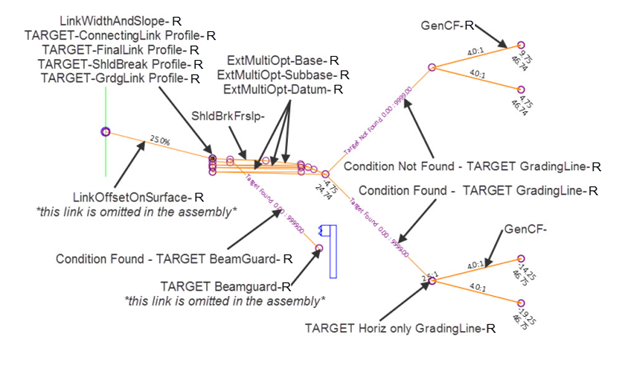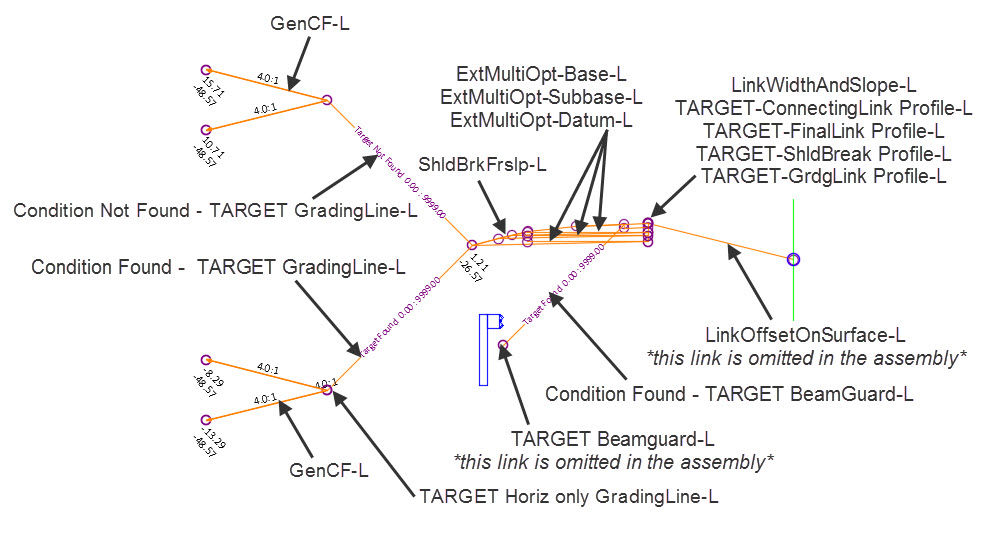Beam Guard - Rehab
Last updated: 2021-02-12
 Description
Description
This is an assembly may be used to model a beamguard energy absorbing terminal (EAT) region in a rehabilitation scenario. Refer to SDD 14B44 for more information on energy absorbing terminals.
The assembly is built to accommodate both left and right side construction. If only one side is desired, the subassemblies may be deleted from the other side. The descriptions in the document are for one side of the assembly. The information is mirrored for the opposite side. This is an example assembly that will likely require modifications to fit specific project needs. Common modifications include:
- Changes to the pavement structure
- Selection of the desired side to model
- Integral paved shoulder vs separate paved shoulder
- Changes to the daylight subassembly to match project conditions.
 Construction
Construction
This assembly consists of 1 LinkOffsetOnSurface subassembly get out to the lane edge location, 1 LinkWidthAndSlope subassembly used to create a near vertical face surface for a shoulder cutout (if desired), 1 LnExtendBase subassembly for the paved shoulder, 1 ShldGeneric subassembly for the unpaved shoulder and 10:1 slope, 2 ConditionFound subassemblies, 1 ConditionNotFound subassembly, 2 LinkWidthAndSlope subassemblies for the beamguard and grading line targets, and 2 DaylightProfileControlled subassemblies. For information on the parameters of these individual subassemblies, consult the respective help files.


LinkOffsetOnSurface-L – This subassembly is used to get out to the left lane edge location using the existing surface for elevation target. Since all subsequent subassemblies are based on this elevation and not a designed profile, it is important for designers to obtain accurate ground survey in these locations.
LinkWidthAndSlope-L– This subassembly is used to read the outside lane superelevation which is then used as a parameter reference to define the slope on all 3 of the ExtMultiOpt subassemblies for creating the starting point codes for the shoulder fill locations.
LinkOffsetOnSurface-R – This subassembly is used to get out to the right lane edge location using the existing surface for elevation target. Since all subsequent subassemblies are based on this elevation and not a designed profile, it is important for designers to obtain accurate ground survey in these locations.
LinkWidthAndSlope-R– This subassembly is used to create a small (0.01') offset from the edge of travel way to the beginning of the shoulder. This offset allows for a near vertical face surface representing a shoulder "cut-out" at that location, if desired.
PavedShld-R– This subassembly is used to model the right paved shoulder. If the paved shoulder is the same thickness and slope as the adjacent lane, this subassembly may be deleted and the paved shoulder can be modeled with the lane.
UnpavedShld-R– This subassembly is used to model the shoulder utilizing a grade break on the shoulder foreslope for use in beam guard modeling. The paved width parameter is used to model the unpaved shoulder and the unpaved width is used to model the 10:1 slope underneath and behind the beam guard. A profile is targeted to transition the foreslope outside of the 10:1. The Include surface widening points parameter is set to "yes" so points are created at the intersection of each base layer and the existing ground surface.
Condition Found - TARGET BeamGuard-L– This conditional subassembly is used to locate any instances of beamguard horizontal targets.
TARGET Beamguard-L– This LinkWidthAndSlope subassembly is used to locate the beamguard horizontal target on the shoulder. The proper feature line code for displaying a beam guard block is created.
Condition Not Found - TARGET GradingLine-L– This conditional subassembly is used to insert DaylightProfileControlled anywhere there is an absence of the Grading Line horizontal linework.
DaylightProfileControlled-NoGradingLine-L– This DaylightProfileControlled is used in the absence of Grading Line horizontal targets.
Condition Found - TARGET GradingLine-L– This conditional subassembly is used to locate any instances of the Grading Line horizontal targets.
TARGET GradingLine and GradingLine slope profile-L– This LinkProfileControlled subassembly is used to form the slope between the subgrade shoulder point and the grading line. A horizontal target for the grading line is required. A profile is required to transition the slope.
DaylightProfileControlled-GradingLine-L– This DaylightProfileControlled is used in the presence of Grading Line horizontal target.
 Corridor parameters
Corridor parameters
See Beam Guard assembly help for example target parameters.